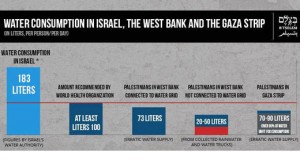Water
Page last updated 30 Oct 2015
Introduction
The Oslo Accords perpetuated the discrimination in allocation of water between Israel and the Palestinians which had existed before, allocating 80 percent of the water pumped from the mountain aquifer – one of three underground water reserves shared by Israel and the Palestinians – to Israel and only 20 percent to the Palestinians. They further established there would be no cap to the supply of water to Israelis, whereas the water supply to Palestinians would be limited to predetermined amounts. All was supposed to be sorted out amicably within five years in a final-status agreement. That was over 22 years ago and still counting. In the meantime, Palestinians suffer from acute shortages of water and exaggerated prices for it when they have to purchase it from the Israeli water company, Mekorot, which Who Profits describes as “actively involved in conducting and maintaining the Israeli occupation”. Israeli per-capita water consumption is more than five times higher than that of West Bank Palestinians.
The situation in Gaza is even worse, with water extracted from the coastal aquifer, Gaza’s main water source, at over three times the rate at which it is replenished. As a result seawater and saline groundwater seep in, contaminating the aquifer’s water. The lack of wastewater treatment in the Gaza Strip exacerbates the problem, as do electricity cuts so plants often can’t operate. Damage to wastewater-treatment facilities in Gaza’s wars have added to the woes, with 90 to 95 percent of Gaza’s main water supply unfit for drinking and problematic even in terms of agricultural use.
Organisations
EWASH, the Emergency Water Sanitation and Hygiene group in the Occupied Palestinian Territory, a coalition of 30 leading humanitarian organisations, runs the Thirsting for Justice Campaign to mobilise European citizens to demand that their governments pressure Israel to change its policies and practices in order to comply with international law and respect Palestinians’ human rights. They produce an Activist’s guide.
Some articles and reports
1. Not Enough Water in the West Bank
A Visualizing Palestine infographic
__________
2. Background: Water crisis
B’tselem, updated Feb 2014
 A comprehensive overview of the water crisis and Israel’s contribution to it. An introductory page links to a number of others, including Discriminatory water supply, Water crisis in Gaza Strip: Over 90% of water un-potable and the right to water in International Law
A comprehensive overview of the water crisis and Israel’s contribution to it. An introductory page links to a number of others, including Discriminatory water supply, Water crisis in Gaza Strip: Over 90% of water un-potable and the right to water in International Law
Two earlier B’tselem reports, produced as contributions to the negotiations during the Oslo process, are still very useful. The extended information sheet Disputed Waters: Israel’s Responsibility for the Water Shortage in the Occupied Territories published in September 1998 was followed in July 2000 by Thirsty for a Solution: The Water Crisis in the Occupied Territories and its Resolution in the Final-Status Agreement. There is also a summary of this report here.
__________
3. Mekorot’s involvement in the Israeli occupation
Who Profits/the Israeli Occupation Industry, Dec 2013
Mekorot, the national state-owned water company of Israel, supplies 90 percent of Israel’s drinking water and provides 80 percent of its water supplies. It is the Israeli government’s executive arm in the OPT for water issues. In East Jerusalem and other parts of the occupied West Bank, Mekorot supplies water to the settlements. It also supplies a substantial share of the water consumed by Palestinians who are prevented from developing their own water sector. As a result, Mekorot is actively involved in conducting and maintaining the Israeli occupation.
__________
4. Drying Palestine: Israel’s Systemic Water War
Muna Dajani, Al-Shabaka, 4 Sep 2014
Dajani argues that Israel has deliberately waged a sustained attack on Palestinian water infrastructure on two fronts: direct and extensive damage caused deliberately during large-scale military operations, and long-term damage done by preventing the repair, maintenance, or development of water infrastructure. Targeting water infrastructure has been an identified and documented tactic of the Israeli military, affirmed recently for instance in the United Nation’s Goldstone Report as “deliberate and systematic”.
__________
Charlotte Silver, Al Jazeera, 30 Mar 2014
Israel boasts about its use of desalination plants and drip-irrigation to make the desert bloom. But, argues Silver, Israel’s main source of water is simple theft…
__________
6. The Israeli ‘watergate’ scandal: The facts about Palestinian water
Amira Hass, Ha’aretz, 16 Feb 2014
“Israel has adopted a drip-feed approach to providing the Palestinians with water instead of letting them control their own natural resource.” A passionate indictment of the way in which control of water is part of the overall control of Palestinian life under occupation.
__________
